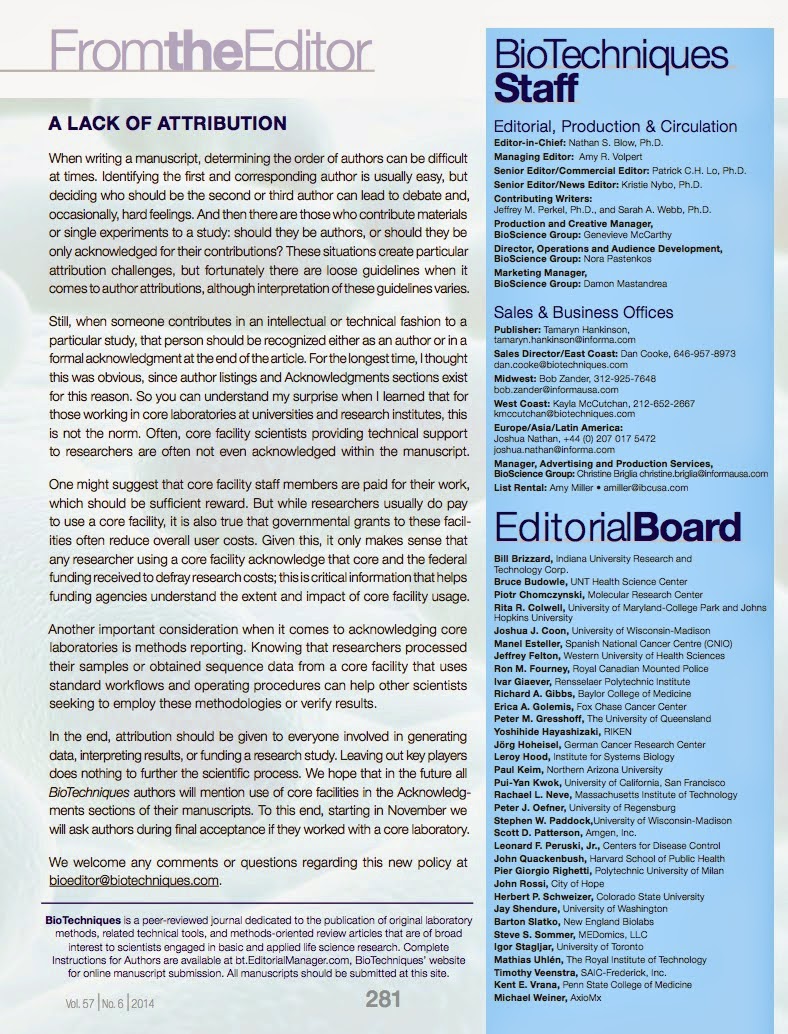 |
| BioTechniques Article on SRL Attribution |
Whether you agree or disagree with this basic tenet is really beyond the scope of this post. What I'd like to share here is my way of fostering the proper relationship with my users such that they feel compelled to acknowledge the excellent work of the core instead of feeling obligated to do so.
What follows is basically a three-part approach to accomplishing the goal of being acknowledged as a core facility in publications that utilize your services. The reason you may wish to do this could vary, but likely involve justification of your core facility's existence to your institution's administrators or various "Centers" you may receive funding from. For example, as part of the University of Chicago's designation as a Comprehensive Cancer Center from the NCI, we must keep track of cancer-related publications that utilize our core facility. So, obviously it would be easiest for us to search PubMed for the inclusion of our core facility's name or even the cancer center support grant number in the reference. However, many times our facility is omitted from the acknowledgement section of the publication. To help modify this behavior, we need to first find the publications, then organize them, and lastly reach out to our authors/users to help them understand why acknowledgements are important. Here are these steps.
Part 1 - Finding publications that should designate attributed to your core facility's work.
 |
| Fig. 1 - Keywords to find references based on your core's services. |
 |
| Figure 2. Part #1 of search yields over 168,000 results. |
 |
| Figure 3. Search restricted to affiliation of University of Chicago |
Next I use the "Add to history" link near the search to hold onto those search results temporarily (Figure 2).
I click the "Add" link next to search #1 to add these 168,000+ results back into the builder, and then refine the search by using the "And" boolean and restricting the "Affiliation" field with 'University of Chicago (Figure 3.)
 |
| Figure 4. Search based on keywords, affiliation, date range |
Once you've created your search criteria and confirmed that it is giving you what you've intended, you'll want to save the search, using the "Save search" link below the search box. Figure 5 shows you some of the options available for setting up the saved search. Note that you'll need a PubMed profile to set this up, so the first time you try and save a search, it'll ask you to create an account. Here, I've chosen to send me an email
 |
| Figure 5. Saving the search and setting up email digest. |
Part 2 - Organize references and tag them to easily create reports later.
In part 2, my goal is to receive these email notifications, skim through the publication and then find a way to organize the references neatly and efficiently.
 |
| Figure 6. Email notification from My NCBI |
Next, I follow the link, and read through the manuscript to ensure the work being reported was in fact from my core. If I'm unsure, I can always ask the author, but I tend to recognize work done on my instruments.
 |
| Figure 7. One-click add to Zotero button in URL bar |
 |
| Figure 8. Zotero Organizing tool for references (running on Mac) |
This makes organizing and searching through references a breeze.
 |
| Figure 9. Thanks for the acknowledgement |
Now comes the hard part. How to suggest to your facility users that they should be acknowledging your core without sounding like a jerk.
As I'm skimming references, I'll quickly jump to the acknowledgement section and check for recognition of the core, or perhaps individual members of the core (either is fine with me). If the user does acknowledge the core, I make sure to send them an email thanking them for doing so. This positive reinforcement goes a long way toward ensuring this type of action recurs in the future. I also explain why it's important to us that the core be acknowledged. An example email is shown in Figure 9. Of course congratulating them on a job well done can only help to sweeten the deal.
 |
| Figure 10. Maybe next time...? |
Of course, you can save these emails as templates and simply change the name and journal to personalize them.
The responses I've received from these emails has been tremendous. I think they are both appreciative of the recognition of their work as well as understanding of the needs of the core to be recognized.
We all understand the need for metrics such as publications and their importance in validating the success of core facilities. However, instead of taking a passive approach and hoping people read your web site asking to be acknowledged, the method proposed here takes a proactive approach that has already increased the desired result.
PubMed is pretty comprehensive, but there could be other sources for finding work being discussed that should point back to your core facility. Magazine articles, intra-institutional articles or highlights, blog posts, etc... all should be explored and stored. You can use a series of other rss feeds or Google search alerts to help you find this information too. Asking a PI to mention the core facility in an intra-institutional newsletter is certainly within your purview.
Happy Hunting!
No comments:
Post a Comment